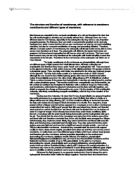Subsequently for the organic solvents and freezing the method is as follows:
Effect of organic solvents and freezing on membrane permeability
For this part of the experiment three test tubes will be used. One will be marked C to represent the chloroform-saturated water, the next one IMS for the IMS solution and the third marked F for freezing which will be done at -20°C instead of the stated liquid nitrogen. 15 ml of chloroform and IMS should be placed in their corresponding test tubes and 15 ml of distilled water should be placed in the tube marked F, then adding a beetroot cylinder to each tube. All tubes should be left in their ideal environment for 20 minutes; as with the varying temperatures the cylinder should be removed and then the tube contents shaken and then poured into cuvettes and the measured for absorbency value.
Results
Here are the corresponding tables for the test tubes
Discussion
Based on the results obtained from the experiment with the various temperatures, it is justifiable to conclude that the permeability of the membrane will vary based on the temperature it is in. This is clearly shown through graph one. The graph is the results of the six test tubes placed in different temperatures ranging from 30°C to 70°C. The graph exhibits a definite correlation representing the basis of how temperature affects permeability; in the case of this experiment the level of absorbency increased when the temperature was also increased. This is related to the fact that the beetroot was placed in various temperatures. The higher the temperature was the more cells of the beet roots burst, thus in turn increasing the absorbency of the each solution. In other words the higher the absorbance was, the more damage had been done to the cell membrane.
This can be explained by understanding the structure and composition of the cell membrane. The cell membrane comprises of a phospholipids bilayer. It is called that because of the structure having two layers of phospholipids, each singular phospholipids comprised of a hydrophilic head and a hydrophobic tail, the head being polar and the tail being non- polar. The tails are end to end, causing the heads to face outwards as they are attracted to water. The bilayer itself has various molecules embedded in its surface. These include transport, channel proteins and other types of proteins, polysaccharide chains. Cholesterol, glycolipds1 Because of the design and nature of the cell membrane, it only allows certain molecules to pass through its bilayer structure.
The components of the cell membrane are sensitive to changes in its surroundings; lipids and fatty acids will in essence melt at high temperatures. This causes the cell membrane to lose its shape and allows more movement2. This then affects the permeability of the cell causing damage by letting molecules normally not allowed into the cell inside. Proteins are also affected, they are sensitive to high temperatures, subjecting material made from proteins e.g., cells, enzymes etc. will cause them to denature and lose their function. In regards to the beet root cells it’s cellular membrane is made up of proteins and lipid and has an ideal temperature, when subjected to temperatures as high as the ones in the experiment it caused denature, causing it to lose its original shape. And with the protein not allowing it to maintain the entry of certain molecules. This in turn causes the release of the pigment held in place by the cell membrane, thus mixing with the 15ml of distilled water. As the graph showed the higher the temperature got the more damaging it was to the cell.
As with temperature the remaining treatments were drawn on a graph to show the variation. From the results it can be seen that the chloroform was most damaging showing a higher absorbance levels than the freezing and IMS solution. Freezing caused low levels of absorbance, because extreme cold temperatures causes the membrane to become more rigid allowing less movement, in relation to the beet root this allowed less molecules to pass through. The IMS solution had a low absorbance in comparison to the chloroform this may be due to the polar nature of all alcohols. Because of their polarity they are not mixable with fats and lipid. The composition of the cellular membrane is mainly lipids and fatty acids. The chloroform had an exceedingly high absorbance value, higher than the absorbance of highest temperature. This results gained suggest that chloroform cause some form of lysis. This causes the detachment from the cell wall, affecting the structure of the bilayer in turn causing the pigment to burst out.
This experiment has shown that putting cells in adverse environments such as the organic solvents and high temperatures are very detrimental to their structure. This has shown that organic solvents have a major effect on the chemical nature of the cellular membrane.
In this experiment some factors should be consider as the solutions used carried in concentration. This is very important because the use of different concentration may provide different results. As well as in the case of the freezing at -20°C, it will not provide the same results as placing in liquid nitrogen, but it will show where the trend may be going towards on the graph.
The basis of the experiment highlighted the factors that contributed to the damage if the beetroot, identifying the tolerance of the cell membrane to various conditions.
Bibliography
-
Barbour, M. et al. (1997) Biology. London: Collins Educational
-
[accessed on November 25th 2010]







